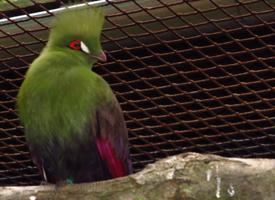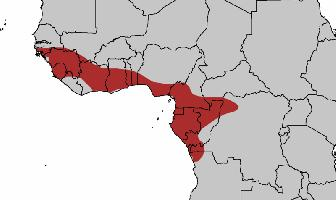
Poids et mesures
| Longueur | de 40 à 43 cm |
|---|---|
| Poids | de 225 à 290 g |
Données biologiques
| Durée de vie | 30 r |
|---|
Statut de conservation
| Menacé |
Description de l'animal
The Guinea turaco, scientifically known as Tauraco persa, is a strikingly vibrant bird native to the forests and woodlands of West Africa. This species belongs to the Musophagidae family, commonly referred to as turacos. It is particularly noted for its unique coloration and distinctive features, making it a fascinating subject of study for ornithologists and bird enthusiasts alike.One of the most remarkable aspects of the Guinea turaco is its vivid green plumage, which covers most of its body. This brilliant coloration is not a result of pigments, but rather a unique structural phenomenon. The green is produced by light refraction within the feather structure, a feature that is characteristic of the turaco family. This means that unlike many other birds, the color remains vibrant and does not fade over time. Adding to its striking appearance, the Guinea turaco also sports a bright red patch around its eyes and a crimson primary wing feather, which is particularly visible in flight.
The bird has a prominent crest on its head, composed of elongated green feathers that can be raised or lowered depending on its mood. Its eyes are surrounded by a naked white or blue skin, which contrasts sharply with its overall coloration. The beak of the Guinea turaco is short, stout, and curved downwards, adapted for its frugivorous diet. The tail is relatively long and squared at the end, aiding in its agile flight through the dense forests it inhabits.
Adult Guinea turacos typically measure between 40 to 43 centimeters in length and weigh around 200 to 325 grams. Their calls are distinctive, consisting of a series of loud, croaky phrases that can carry over long distances. These calls play a crucial role in social interactions, territorial disputes, and mating rituals.
Guinea turacos are primarily frugivorous, feeding on a wide variety of fruits, berries, and occasionally leaves, flowers, and insects. Their diet is rich in water, reducing their need to drink. They are known to be highly social birds, often seen in pairs or small groups. During the breeding season, they become more territorial and can be observed performing elaborate courtship displays, which include bobbing movements, spreading their wings to display the red flight feathers, and loud calling.
Nesting typically occurs in trees, where the female lays two to three eggs. Both parents share the responsibility of incubating the eggs and feeding the chicks. The young are altricial, meaning they are born in a relatively undeveloped state and require significant parental care before they can leave the nest.
In terms of conservation status, the Guinea turaco is currently listed as Least Concern by the International Union for Conservation of Nature (IUCN). Although it faces threats from habitat destruction and fragmentation, it benefits from a relatively wide distribution and seems to be adaptable to some degree of habitat change. However, continued monitoring and conservation efforts are essential to ensure that this vibrant bird remains a common sight in the forests of West Africa.
Carte de répartition

Nouvelles photos d'animaux
Top 10 des animaux
- Dolphin gull (Leucophaeus scoresbii)
- Japanese macaque (Macaca fuscata)
- Stone loach (Barbatula barbatula)
- Greek tortoise (Testudo graeca)
- Russian tortoise (Testudo horsfieldii)
- Galápagos tortoise (Geochelone nigra complex)
- Diana monkey (Cercopithecus diana)
- Moustached guenon (Cercopithecus cephus)
- Common flying dragon (Draco volans)
- Galápagos penguin (Spheniscus mendiculus)